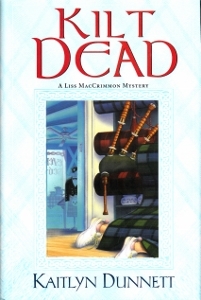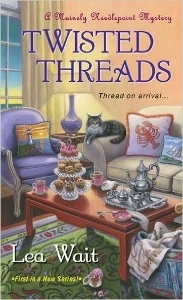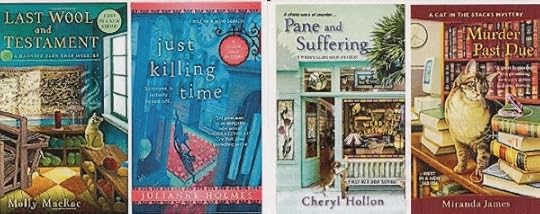Back to the Old Home Town: Why is this plot device used so often?
 Kaitlyn Dunnett/Kathy Lynn Emerson here, today blogging about a topic that came up in the Q&A session after a panel I was part of not too long ago. The gist of the question was: why do so many cozy series (and not just cozies) begin with the sleuth returning to her old home town after X number of years away? Unspoken may have been another question: why do you writers keep using this tired old device?
Kaitlyn Dunnett/Kathy Lynn Emerson here, today blogging about a topic that came up in the Q&A session after a panel I was part of not too long ago. The gist of the question was: why do so many cozy series (and not just cozies) begin with the sleuth returning to her old home town after X number of years away? Unspoken may have been another question: why do you writers keep using this tired old device?
Well, yes, I have to admit that many of us have begun book one in a series with this particular set up, but there is a good reason for it. In fact, if you look at most mysteries—heck, look at most novels!—there are only three choices a writer has about the setting in relation to the protagonist. One is that the character is a long-time resident who already knows a great deal about the other characters. Miss Marple comes to mind. The second is that he or she is a newcomer to the area and therefore experiences people and places for the first time and brings an outsider’s perspective and a fresh point of view to the story (and to solving the crime). The third choice is to use a protagonist who has returned to a place she once knew well. To my mind, choice #3 has huge advantages over the other two because this situation combines the best parts of both of them. The sleuth has a certain degree of familiarity with people and places and is not dealing only with total strangers. At the same time, things have changed while she was elsewhere and she will need to rely on one or more of the characters who stayed behind to help put the pieces of the puzzle together.
 I would argue that this plot device can’t be overused simply because there are so many variations. The reason she comes back is probably the biggest one. In my Liss MacCrimmon series, it is because Liss has suffered a career-ending knee injury and needs a place to recover and decide what she’s going to do next. She was a professional Scottish dancer. In the first book in the series, Kilt Dead, she fills in for her aunt by running the family business, Moosetookalook Scottish Emporium. For Barb Ross’s sleuth, Julia Snowden, in the Maine Clambake Mysteries, it is a family financial crisis that brings her back to Busman’s Harbor, Maine, while in Lea Wait’s Mainely Needlepoint Mysteries, Angie Curtis returns to Maine in response to a phone call from her grandmother telling her that her mother, who disappeared many years before, has been found. That is also the murder Angie must solve.
I would argue that this plot device can’t be overused simply because there are so many variations. The reason she comes back is probably the biggest one. In my Liss MacCrimmon series, it is because Liss has suffered a career-ending knee injury and needs a place to recover and decide what she’s going to do next. She was a professional Scottish dancer. In the first book in the series, Kilt Dead, she fills in for her aunt by running the family business, Moosetookalook Scottish Emporium. For Barb Ross’s sleuth, Julia Snowden, in the Maine Clambake Mysteries, it is a family financial crisis that brings her back to Busman’s Harbor, Maine, while in Lea Wait’s Mainely Needlepoint Mysteries, Angie Curtis returns to Maine in response to a phone call from her grandmother telling her that her mother, who disappeared many years before, has been found. That is also the murder Angie must solve.
 The death of a parent or grandparent and/or an inheritance to be dealt with is what brings many protagonists back home (or at least to a place where they spent part of their childhood). In Molly MacRae’s Haunted Yarn Shop Mysteries, Kath Rutledge receives a twofold inheritance from her grandmother—the yarn shop and the onset of hereditary psychic abilities. The first of Julianne Holmes’s Clock Shop Mysteries sends a grieving Ruth Clagan to deal with her grandfather’s business in a town where she spent many of her summers. The debut of Cheryl Hollon’s Webb’s Glass Shop Mysteries has Savannah Webb taking over the family stained glass business. On the surface, these set-ups sound similar, but they contain a great deal of variety, and not just in the type of store their protagonists inherit.
The death of a parent or grandparent and/or an inheritance to be dealt with is what brings many protagonists back home (or at least to a place where they spent part of their childhood). In Molly MacRae’s Haunted Yarn Shop Mysteries, Kath Rutledge receives a twofold inheritance from her grandmother—the yarn shop and the onset of hereditary psychic abilities. The first of Julianne Holmes’s Clock Shop Mysteries sends a grieving Ruth Clagan to deal with her grandfather’s business in a town where she spent many of her summers. The debut of Cheryl Hollon’s Webb’s Glass Shop Mysteries has Savannah Webb taking over the family stained glass business. On the surface, these set-ups sound similar, but they contain a great deal of variety, and not just in the type of store their protagonists inherit.
The character of the home town varies as widely as the emotional baggage the sleuth brings with her when she returns to a once familiar place. Coastal Maine and the Western Maine mountains are different worlds. Blue Plum, Tennessee is not Orchard, Massachusetts. Nor is it Athena, Mississippi, the setting for two series by the prolific Miranda (aka Dean) James. In the Cat in the Stacks Mysteries, Charlie Harris, a librarian, has returned to Athena after inheriting a house from his aunt.
When I started work on an idea for a new series, it never occurred to me that I was repeating myself by having the new sleuth return to her old home town. In fact, going back is kind of the point of the book. Mikki Lincoln is a woman my age (sixty-eight) who moved away right after high school. It’s an invitation to her fiftieth high school reunion that gets her thinking about her old stomping ground. A recent widow, she sells her home in Maine and heads for the rural New York state community where she grew up. In fifty years, there have definitely been changes. She’s in familiar territory . . . and yet she’s not. For an amateur sleuth, that seems to me to be the best of all possible worlds.
Kathy Lynn Emerson/Kaitlyn Dunnett is the author of over fifty books written under several names. She won the Agatha Award for best mystery nonfiction of 2008 for How to Write Killer Historical Mysteries and was an Agatha Award finalist in 2015 in the best mystery short story category for “The Blessing Witch.” Currently she writes the contemporary Liss MacCrimmon Mysteries (Kilt at the Highland Games ~ July 2016) as Kaitlyn and the historical Mistress Jaffrey Mysteries (Murder in the Merchant’s Hall) as Kathy. The latter series is a spin-off from her earlier “Face Down” series and is set in Elizabethan England. Her websites are www.KaitlynDunnett.com and www.KathyLynnEmerson.com





